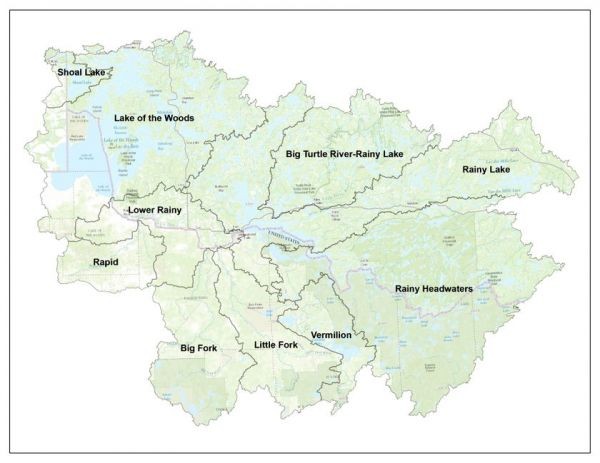White Iron Chain Of Lakes Association
What is a Watershed and what’s unique about ours?
By Kelli Saunders, published July 10th, 2019 (minor editing for style)
 Everyone lives in a watershed and we live in what’s called the Rainy-Lake of the Woods Watershed, a massive basin, with its beginnings (called headwaters) only a short distance west of Lake Superior. A watershed is like a bathtub or catch basin, defined by high points and ridgelines that descend into lower elevations and stream valleys. A watershed carries water that is “shed” from the land after rain falls and snow melts. Drop by drop, water is channeled into the soils, groundwater, creeks and streams, making its way to larger rivers, lakes and eventually, the sea. Water interacts with all that it comes in contact with – the land it traverses and the soils through which it travels. Most importantly, what we do to the land and air affects water quality for all communities living downstream from us.
Everyone lives in a watershed and we live in what’s called the Rainy-Lake of the Woods Watershed, a massive basin, with its beginnings (called headwaters) only a short distance west of Lake Superior. A watershed is like a bathtub or catch basin, defined by high points and ridgelines that descend into lower elevations and stream valleys. A watershed carries water that is “shed” from the land after rain falls and snow melts. Drop by drop, water is channeled into the soils, groundwater, creeks and streams, making its way to larger rivers, lakes and eventually, the sea. Water interacts with all that it comes in contact with – the land it traverses and the soils through which it travels. Most importantly, what we do to the land and air affects water quality for all communities living downstream from us.
The Rainy-Lake of the Woods Watershed is 69,750 sq. km, roughly 400 km east to west and 260 km north to south. About 41% of the watershed is in the U.S. and 59% is in Canada. If you’ve travelled to Atikokan or Upsala in Ontario or Ely or Cook in Minnesota, you were still in our watershed. If you’ve paddled the Turtle River in Ontario or fished in Vermilion Lake in Minnesota, you were still in our watershed. Approximately 14% of the watershed is open water; where there is land, 93% is covered by forest or grassland, and much of that is within provincial parks and national forests. Only 6.4% of the land base is agricultural, mostly found in the lower Rainy River area.
In our watershed, all the water flows towards either the Rainy River or Lake of the Woods, funnels into the Winnipeg River at Kenora and eventually reaches Lake Winnipeg. About 70% of the water that flows into Lake of the Woods comes directly from the Rainy River, which, of course, is half in Canada and half in the U.S. This truly makes our watershed unique – water knows no boundaries. As demonstrated naturally here, although the water comes from two countries, it meets up in one common place – right here in Kenora where our outlets steer it off to travel into another province to yet again mingle with new water.
Kelli Saunders, M.Sc., is the International Watershed Coordinator with the Lake of the Woods Water Sustainability Foundation.
When you subscribe to the blog, we will send you an e-mail when there are new updates on the site so you wouldn't miss them.